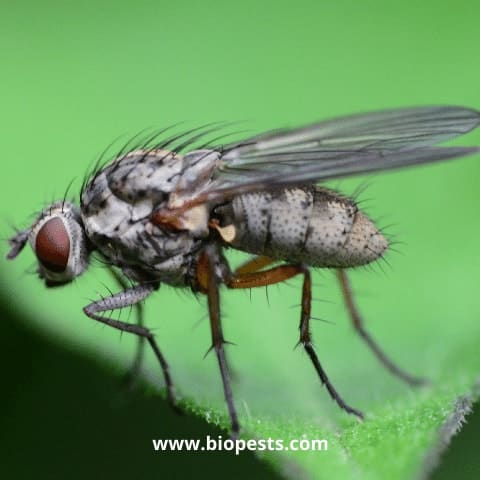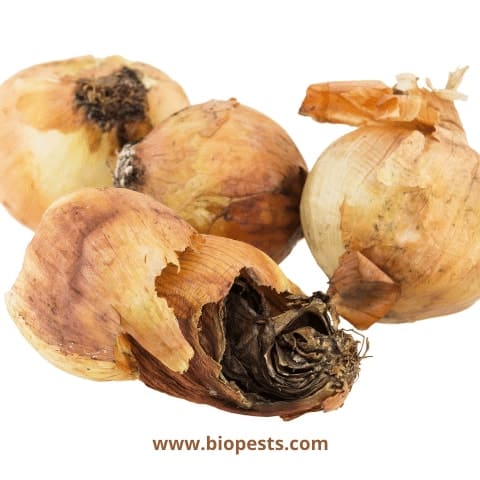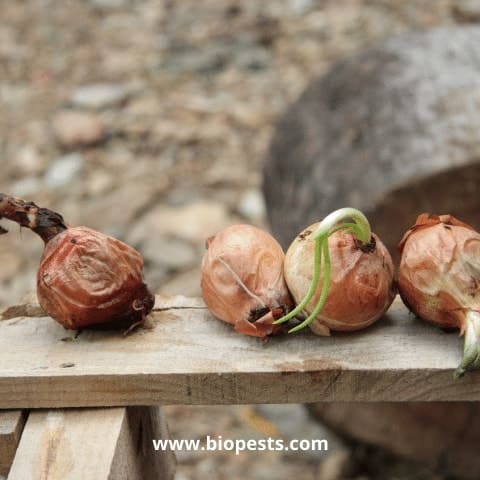Onions (Allium cepa L.) are one of the most popular vegetables grown in the garden and are the basis of almost all the cooking recipes.
Generally speaking, onions are quite a robust vegetable, and usually, we refer to them as resistant to all kinds of parasites. Any beginner gardener knows that onions are excellent as companion plants because of their strong fragrance that repels most insects.
Perhaps not everyone knows, however, that despite being a fairly robust plant, even onions can be subject to attack by some types of insects.
If your onion plants have a sudden yellowing of their leaves and the bulbs start to rot, know that your onions are the victim of pest infestation.
In this article, I would like to talk about how to identify onion pests, prevent and fight them with effective organic measures.
Which Are The Pests That Attack Onions?
The most common onion insect pests are:
- The onion fly (Delia antiqua)
- Thrips (Frankliniella occidentalis and Thrips tabaci).
Among those responsible for the most common onion diseases are:
- Peronospora fungus (downy mildew)
- Botrytis fungus
- Fusarium
What Is The Onion Fly, The One That Is Responsible For The Maggots In Your Onions?
The onion fly is known by the scientific name of Delia Antiqua or Hylemya Antiqua. An adult onion fly insect measures 6-8mm and is ash gray in color. Male specimens differ from females due to the presence of a longitudinal stripe on the abdomen.

The favorite food of the onion fly is mainly onion. These flies spend the winter in the ground. In spring, the female specimens wake up and lay their eggs inside the onion bulb or at the base of the plant. After about a week, the larvae are born, which have a whitish appearance. They settle in the bulb of the plant where they will remain, depending on the external temperature from 3 to 6 weeks. They feed on the bulb tissues until they reach maturity.
Attacked plants immediately show a yellowing of the leaves. The bulbs begin to rot as the larvae feed on the outermost tissues up to the inside. This will open to exposure to bacteria and fungi and to a progressive rot.
Subsequently, the larvae emerge from the bulbs to go into the ground to pupate. Once spring is reached, the first adults flicker and the mating of the females begins.
The reproductive cycle of the onion fly can repeat itself up to 3 or 4 generations in a year!
The greatest damage is caused by the first generation of flies. This is due to the fact that the onion bulbs are relatively young and to the prolonged presence of the larvae, which spend about a month feeding on the bulbs.
As always, prevention is better than cure. Let’s try to see how it is possible to reduce the damage that these parasites do to the onions.
How To Protect Your Onion Crops From The Onion Fly
Insect infestations on onions usually occur in spring and in summer. It is very important to intervene promptly because these parasites reproduce and proliferate very quickly. To do this, timing is decisive, meaning that in the warm seasons you will need to carry out periodic and scrupulous checks.
To prevent the infestation of the onion fly, it is good to guarantee your onions optimal growth conditions that will help to strengthen them.
Here are 11 tips on how to protect your onion crops from onion fly and other pests:
- Consider delaying planting until further on in the season.
- Cultivate onions in a well-drained and aerated soil, better if exposed to the sun and free of water stagnation.
- Turning the soil with repeated hoeing in autumn can help to limit the presence of onion flies.
- Perform frequent irrigation while the vegetables are in their vegetative phase.
- Use mulch.
- Add organic matter of well-ripe manure or compost. Better still if it is vermicompost.
- Choose rustic varieties that are notoriously stronger and less prone to attacks by parasites and diseases.
- Carry out crop rotation.
- Use onions as a companion plant to other crops (such as carrots, salads, radicchio, celery, or tansy). These companion plants release insect repellent substances.
- You can apply organic measures within everyone’s reach: sprinkle some chili powder, ginger, or pepper directly on the soil. You can also sprinkle some Diatomaceous earth, which will kill all pests on the ground. Diatomaceous earth is completely safe for humans and pets.
- It is possible to prepare vegetable pesticides based on wormwood or lavender at home. Wormwood (Artemisia absinthium) is an herb with a distinctive aroma, native to Europe, but it grows in many countries including parts of Asia, Africa, South America, and the United States. These botanicals have a repellent action and are a valid organic preventive method. The wormwood preparation is in fact a filtered decoction of the whole plant. The product must be sprayed on the onion leaves once a week and should not be used in the fifteen days prior to harvest. The lavender preparation (Lavandula) is a decoction of the leaves and flowers of the plant. If you want to know more about the many uses of botanical pesticides in the garden, read here.

What Are Onion Thrips?
Onion thrips are the second most important onion pests. There are two species that attack the onion: Frankliniella Occidentalis and Thrips Tabaci. Frankliniella individuals are quite light in the juvenile stage, and they are about 0.03 inches long. At the adult stage, their colors vary between ocher and brown depending on the season. The adults of Thrips tabaci are about 0.03 to 0.07 inches long and are equipped with narrow, long, and fringed wings.
This tiny insect lives on the leaves of the onion, sheltering itself during the hottest moments of the day inside the leaf sheaths. With its mouthparts it sucks the sap of the plant, visibly damaging it.
Similar to the onion fly, after wintering in the ground or in the bulbs, the female thrips lay their eggs in spring, inside the onion tissues. After a week, the nymphs emerge out of the eggs and begin to feed on the onion tissues. The subsequent stages of the insect (prepupae, pupae) also feed on the onion tissues through stings, which give rise to depigmented areas or necrotic changes. Thrips are responsible for the formation of spots on the initially greenish leaves, which first become silver and then necrotic. The affected leaves, especially the younger ones, will show wilting and drying.
In short, the reduction of the leaf surface determines a decrease of photosynthesis, which leads to a limited harvest.
Other Onion Pests And Diseases:
In addition to the pests we talked about earlier, onion plants can be affected by other insects and fungal diseases. These are the main fungal diseases:
Peronospora Destructor (Downy Mildew)
Peronospora destructor is one of the most serious fungal diseases of the onion and other plants of the genus Allium (shallot, garlic, leek). This fungus causes downy mildew on leaves and considerable damage both in terms of quantity and quality of the bulbs.
Downy mildew is a devastating disease, affecting a wide range of plants, not just onions. Just to give you an example, potatoes and tomatoes can also be affected by this fungus.
Downy mildew is a fungal infection that blocks onion development and causes it to rot. When harvested, the onions are small and rot after a few days. Its development is strongly conditioned by humidity. For this reason, the plants are more prone to downy mildew attacks in very rainy periods and in humid climate areas.

Unfortunately, once the plant has been affected by the disease, there is little that can be done since there is no cure for already damaged plants. Prevention is the best way to fight downy mildew. Let’s first see how to recognize the symptoms:
The disease affects young seedlings, blocking their growth. When it hits more mature plants, onions appear healthy on the outside but turn out to be rotten on the inside.
This fungus expands very quickly and once the problem is noticed, the infection must be immediately stemmed before the entire garden is affected.
The main symptoms of onion blight are:
• Affected leaves turn yellow and dry at the tip. They tend to fold towards the ground and rot.
• Mold on the leaves with a color range from brown to purple
• Discolored and longitudinal spots along the entire length of the leaf.
How To Prevent Downy Mildew on Onions
Here are some tips on how to prevent downy mildew on your onion crops:
- Prepare the soil
Downy mildew thrives in stagnant water. Hard and clay-like soil creates the ideal conditions for its proliferation. Prepare a well-drained and well-ventilated soil for your onions. Fertilizing the soil with earthworm humus improves the consistency of the soil by discouraging the spread of this disease.
- Rotate crops
Each year, change the location of your onion plants. If you plant the onions in the same location as in the previous year, you increase the risk of left over spores which will attack the new plants.
- Avoid excess watering
As has already been mentioned, this fungus loves moisture. Excess water is one of the greatest dangers to onions health! Avoid watering your onions too much so as not to allow the formation of water stagnation.
If your winters are particularly rainy, the ideal would be to plant your onions in a cold frame.
- Treat the foliage with a fungicide
To combat this disease, copper-based fungicides can be purchased. It is also possible to prepare a powerful fungicide yourself using baking soda. Just mix 100 grams of it in 1 liter of water and spray directly on the leaves, being careful not to spray on the ground.
Botrytis Leaf Blight:
Botrytis is a fungus disease caused by the fungus Botrytis squamosa and Botrytis allii. The symptoms are small light-colored spots on the entire surface of the leaves. The spot dimensions range from 0.06 to 0.25 inches. This disease causes the leaves of the plant to die early, causing a considerable reduction in the development of the bulbs. The bulbs affected by this disease become brown, soft, and spongy.
As with downy mildew, botrytis also spreads rapidly in relatively hot temperatures and high humidity. The same preventive measures to be adopted in case of downy mildew must also be used to combat botrytis.
Fusarioum
Another deadly disease for onions is Fusarioum (Fusarium oxysporum), a fungus of the Nectriacee family. it can attack the onion, especially when temperatures reach 77-90 F. This fungus penetrates the vascular tissues of the plant weakening it, starting from the basal leaves and causing the darkening of the stem, chlorosis, growth retardation, wilting, and drying of the crop.
In order to prevent fusarium disease, the quality of the soil is very important. Make sure you are using light soil, packed with organic matter such as the vermicompost.
Some of the links above are affiliate links, meaning, at no additional cost to you, I will earn a commission if you click through and make a purchase.
